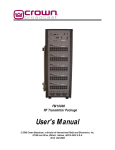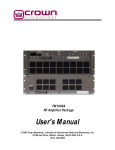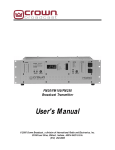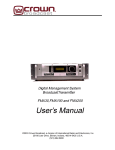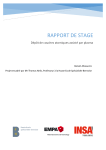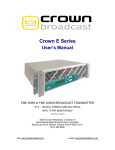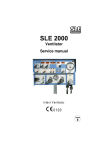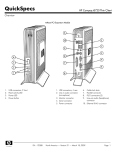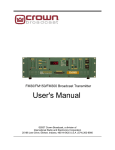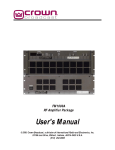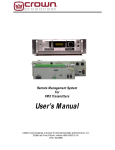Download Crown FMX250 User`s manual
Transcript
® FM4000 RF Transmitter Package User's Manual ©2005 Crown Broadcast, a division of International Radio and Electronics, Inc. 25166 Leer Drive, Elkhart, Indiana, 46514-5425 U.S.A. (574) 262-8900 i Revision Control Revision Print Date Initial Release (Rev. 1) September 2005 Important Notices ©2005, Crown Broadcast, a division of International Radio and Electronics, Inc. All rights reserved. No part of this publication may be reproduced, transmitted, transcribed, stored in a retrieval system, or translated into any language in any form by any means without the written permission of Crown International, Inc. Printed in U.S.A. Crown attempts to provide information that is accurate, complete, and useful. Should you find inadequacies in the text, please send your comments to the following address: International Radio and Electronics 25166 Leer Drive, P.O. Box 2000 Elkhart, Indiana, 46515-2000 U.S.A. ii Contents Section 1—Getting Acquainted 1.1 Your Amplifier Package .................................................................................... 1–2 1.2 Amplifier Package Specifications ...................................................................... 1–3 1.3 Safety Considerations ....................................................................................... 1–4 1.3.1 Dangers .......................................................................................................... 1–4 1.3.2 Warnings ........................................................................................................ 1–4 1.3.3 Cautions ......................................................................................................... 1–4 Section 2—Installation 2.1 Operating Environment ..................................................................................... 2–2 2.2 Tools Required .................................................................................................. 2–2 2.3 Unpacking ......................................................................................................... 2–2 2.4 Preinstallation ................................................................................................... 2–3 2.4.1 Power Amplifier Modules ............................................................................... 2–3 2.4.2 Hubble Twist Lock® Connector Wiring .......................................................... 2–4 2.5 Installation ........................................................................................................ 2–8 2.6 Remote I/O Connection ..................................................................................... 2–9 Section 3—Operation 3.1 Initial Power-up Procedures.............................................................................. 3–2 3.2 Power Switches ................................................................................................ 3–4 3.2.1 AC Input Circuit Breaker ............................................................................... 3–4 3.2.2 DC Power Switch .......................................................................................... 3–5 3.2.3 Interlock Switch ............................................................................................ 3–5 3.3 Digital Multimeter ............................................................................................. 3–6 3.4 Fault Indicators ................................................................................................. 3–7 3.5 Fuse Indicators ................................................................................................. 3–8 Section 4—Reference Drawings 4.1 Views ....................................................................................................................... 4–2 4.2 Block Diagram .................................................................................................. 4–3 4.3 Transmitter Controller Board Component ID..................................................... 4–4 4.4 Transmitter Controller Board Schematic........................................................... 4–5 Section 5—Service and Support 5.1 5.2 5.3 Service..............................................................................................................5–2 24–Hour Support..............................................................................................5–2 Spare Parts.......................................................................................................5–2 Glossary Index iii Glossary Index iv I INFORMATION Section 1—Getting Acquainted This section provides a general description of the FM4000 transmitter system and introduces you to safety conventions used within this document. Review this material before installing or operating the system. Getting Acquainted 1–1 I 1.1 Your Transmitter Package The FM4000 is a highly efficient transmitter package designed to set a new standard in FM transmitter design offering modularity, ease of use, and long-term reliability. The FM4000 package includes two (2) PA2000 amplifiers, two (2) PS2000 power supplies, a combiner with coupler, a transmitter controller, and all necessary cabling. The PA4000 transmitter package requires no tuning and typically provides 75% RF efficiency across the band. The PS2000 power supplies are power factor corrected and 90% efficient. Modern MOSFET technology ensures high AC to RF efficiency (better than 70% overall) and long-term reliability. The unmatched efficiency of this transmitter significantly improves your bottom line by providing cooler operation and lower power costs. These modular units are uniquely designed to be lightweight and compact for convenient shipping, and require only fourteen RU spaces for installation. Installation is made simple with just three interconnections between each amplifier and power supply. In addition, built-in digital metering and status indicator capabilities enable intuitive operation to further augment the user-friendly design. Economic long-term reliability is ensured through our carefully engineered solidstate design. Each PA2000 features four field-replaceable 500–watt power modules. This transmitter delivers 400 to over 4000 watts of RF power output. Use your existing exciter or purchase the FM4000T which includes our award-winning FM250 exciter for an unbeatable 4 kW transmitter package. Illustration 1–1 FM4000 Transmitter Package 1–2 FM4000 User’s Manual 1.2 Transmitter Package Specifications RF Power Output: 400 to 4400 watts continuous with remote controlled power adjust RF Drive Requirement: 140 watts for full output RF Output Impedance: 50 ohms (unbalanced) Maximum SWR: 1.7:1 (With power foldback at high SWR) Frequency Range: 87–108 MHz RF Harmonics/Spurious Products: Better than –80 dB Asynchronous AM S/N Ratio: Better than –55 dB with 100% modulation at 400 Hz, no de-emphasis, no FM modulation (typically > 60 dB) Synchronous AM S/N Ratio: Better than –55 dB with 100% modulation at 400 Hz, no de-emphasis, FM modulation=75 kHz @400 Hz (typically > 60 dB) Operating Environment: Temperature Range: Humidity Range: 0°–50°C at sea level 0–80% at 20°C (noncondensing) AC Power: 240 Volts AC +10/-15%, 50–60 Hz; (120 Volts AC for driver) Power Consumption: Less than 5600 watts at 4400 watts RF output typical Power Factor: .96 typical Overall Efficiency: 70% typical RF Output Connector: 7/8 in. EIA flange, 7–16 in DIN optional Power Amplifier Chassis: 7 x 17.25 x 23 inches (17.78 x 43.82 x 58.42 cm) exclusive of rack ears, but inclusive of connectors Power Supply Chassis: 5.25 x 17.25 x 23 inches (13.34 x 43.82 x 58.42 cm) exclusive of rack ears Weight: PA2000—40 pounds (18.1 kg) RF PA Modules—8 pounds (3.6 kg) each PS2000—43 pounds (19.5 kg) Note: System performance is specified using Crown Broadcast Model FM250 Exciter where applicable. Getting Acquainted 1–3 I 1.3 Safety Considerations Crown Broadcast assumes the responsibility for providing you a safe product and safety guidelines during its use. “Safety” means protection to all individuals who install, operate, and service the transmitter as well as protection of the transmitter itself. To promote safety, we use standard hazard alert labeling on the product and in this manual. Follow the associated guidelines to avoid potential hazard. 1.3.1 Dangers DANGER represents the most severe hazard alert. Extreme bodily harm or death will occur if DANGER guidelines are not followed. 1.3.2 Warnings WARNING represents hazards which could result in severe injury or death. 1.3.3 Cautions CAUTION indicates potential personal injury or equipment or property damage if the associated guidelines are not followed. Particular cautions in this text also indicate unauthorized radio-frequency operation. Type of Hazard WARNING Severe shock hazard! Pictorial Indication of Hazard Turn power off and wait approximately 1 minute for capacitors to discharge before handling them. Explanation of Hazard Illustration 1–3 Sample Hazard Alert 1–4 FM4000 User’s Manual ® Section 2—Installation This section provides important guidelines for installing your transmitter. Review this information carefully for proper installation. Installation 2–1 2.1 Operating Environment You can install the FM4000 transmitter in a standard 19–inch component rack or a cabinet or our own pre-wired cabinet on any flat surface. In any case, the area should should be as clean and well-ventillated as possible. The power supply must be installed directly below the power amplifier (for the included dressed cables to reach their respective connectors). 2.2 Tools Required To install the power supply and power amplifier, you will need the following tools: ❑ Medium phillips screwdriver ❑ Medium flat-blade screwdriver ❑ Small flat-blade screwdriver ❑ 7/16–Inch wrench or nut driver ❑ ESD (Electrostatic Discharge) protection grounding strap and/or mat. 2.3 Unpacking Before handling any exposed printed circuit boards, ground yourself with an antistatic strap and/or mat. CAUTION Possible equipment damage! Guard against electrostatic discharge through electronic components. The power amplifiers, power supplies, and eight power amplifier modules are packed and shipped in individual boxes because of their modular nature. If you have purchased a pre-wired cabinet, you may disregard the next section and proceed to step 2.5. . For added protection, both of the PA2000 amplifiers and PS2000 supplies are packed in an inner box and then placed inside an outer box with styrofoam protective corners in both boxes. You will need to unpack a total of eight boxes (plus two inner boxes). Note: Save the boxes and packaging material that the individual units are packed in should you need to return them for factory service. 2–2 FM4000 User’s Manual 2.4 Pre-installation 2.4.1 Power Amplifier Modules If you have ordered a cabinet system, proceed to step 2.5. Each PA2000 incorporates eight power amplifiers (two each in four modules. Due to possible damage during shipment, the modules have been removed. Follow these steps to install the modules: 1. Remove each front panel of each PA2000 (four screws). 2. Taking ESD precautions (see page 2–2), unpack the power modules and place them on your work area with the circuit sides up. Connector Warning Label Slide Rail Illustration 2–1 Power Amplifier Module 3. The warning labels on the front of the modules should all be positioned to the center of the chassis, also note the position of the connector on the modules and in the chassis. 4. Insert the eight power modules, using their slide rails, into the built in channels of the right and left side cavities as shown below. Note that the connectors and warning labels are nearest the middle wall or partition of each PA2000. Before installation After installation Illustration 2–2 Power Amplifier Module Placement 5. Be sure the modules are pushed in completely so that the connector makes proper contact. 6. Replace each front panel of each PA2000. Installation 2–3 2.4.2 Hubble Twist Lock® Connector Wiring Prepare the wiring for the Hubble Twist-Lock® connector in the following manner before connecting to your AC power source: 1. Use round cord with a diameter of 0.385–0.780 inches (10–20 mm), Type SJ 12/3 – 10/3; Type S 16/3 – 10/3. 2. Select conductor size from your National Electrical Code®. 3. Slide the cover onto the cord. Remove insulation from cable and conductors as shown in Illustration 2–3. Do not tin conductors. 1 Inch (25 mm) 5/8 Inch (16 mm) Illustration 2–3 Cover, Cable & Conductors 4. Loosen terminal screws. Insert conductors fully into proper terminals according to the table below. Take caution that there are no stray wire strands. Terminal Conductor Green Hex Head Screw Equipment grounding conductor (green or green/yellow) Brass Screw Hot circuit conductor, 240 VAC (NOT white, NOT green) Brass/Black Screw Hot circuit conductor, 240 VAC (NOT white, NOT green) 5. Tighten terminal screws to 18 pound•inches (2.1 N•m) of torque. 6. Tighten assembly screws to 10 pound•inches (1.1 N•m) of torque. 7. Tighten cord clamp screws to 10 pound•inches (1.1 N•m) of torque. WARNING Possible Electric Shock Hazard! Do not connect AC source until all other connections are made and installation is complete. 2–4 FM4000 User’s Manual 2.4.3 System Wiring Refer to page 4-3 Section 4.2 Block diagram when connecting together the different components of the FM4000 system. 1) Mount each of the components of the FM4000 system in an appropriate 19" rack as shown in illustration 2-6. Transmitter Controller FMX250 or equivalent PA2000 1 RU Spacer PS2000 PA2000 PS2000 Illustration 2-6 FM4000 Rack definition 2) Locate the DB-9 Male-to-Male cable and connect between 'Control' on both the PA and PS. The 'Control' point for each is shown in Illustration 2-7. Back of Power Supply DB-9 Control Back of Power Amp DB-9 Control Illustration 2-7 Control point locations Installation 2–5 3) Locate the DB-25 Male-to-Male cables and connect between 'I/O' port on both of the PA's and the ports labled PA1 and PA2 on the Transmitter Controller with the top PA going to PA1. The I/O ports and PA input ports for each is shown in Illustration 2-8. Back of Power Amp Back of Transmitter Controller RF Input DB-25 I/O port DB-25 I/O port Illustration 2-8 I/O port locations 4) Locate the cable assembly with the "N" type connectors that are connected together with a "N" style Female "T". Each of the ends of this assembly should connect to the "RF Input" located on the back panel of each PA. This cable is RG-11 type and is labeled as such. See Illustration 2-8 for location of RF Input. The center of this assembly should have an open female "N" connector. Locate the 3 foot RG-214 cable (labeled 101635-1) and attach it between this point and the RF output of the FMX250. Refer to Illustration 4-3 on page 4-3 of section 4 for further information. Installation 2–6 5) Locate and mount the combiner assembly, including the directional coupler, in a location so that the RF input connectors on the combiner are in close proximity to the RF output connectors of each of the PA's. See Illustration 2-9 for a suggested mounting technique and location. Illustration 2-9 Output Combiner Mounting recommendation 6) Locate the RF Output cables (labeled 200797-CBL) and attach one end to the RF output connector on the back of each PA. Do not tighten the connectors at this point. Attach the other ends to the Combiner as shown in Illustration 2-9. Tighten both ends of the cables at this time. 7) Locate the DB-9 connector on the end of the Directional Coupler and connect it to the DB-9 port labeled 'Directional Coupler' on the back of the Transmitter Controller as shown in Illustration 2-10. Illustration 2-10 Directional Coupler port and directional coupler Installation 2–7 2.5 Installation 2.5.1 AC Power Input Block WARNING Possible Electric Shock Hazard! Do not connect AC source until all other connections are made and installation is complete. Remove the 4 screws and the AC block cover as shown in Illustration 2-11 for access to the AC input block. Save these screws and cover for later re-installation. Illustration 2-11 AC block access Attach main AC feed to the appropriate points as labled in Illustration 2-12. Illustration 2-12 AC block feed point definition The AC mains feed-point requires 240 Volts single phase with neutral (which allows for 120 Volt supply). The following is the AC feed-point supply requirements : 240 VAC single phase @ 30 Amps 120 VAC single phase @ 15 Amps (Neutral wire) Provide the appropriate supply feed to match these requirements. Consult the National Electrical Code for your area for proper conductor size and color. Installation 2–8 2.5.2 RF Output Connection The RF Output connection is on the end of the combiner that has the cooling fan block installed on it. See illustration 2-13 for the location of the connector. It comes standard as a 7/8" EIA Flanged connector. An optional 7/16" DIN connector can be ordered if desired. RF Output (7/8" EIA Flanged) Illustration 2-13 RF Output connection 2.5.3 Audio Input Connection The Audio input connection is an XLR Female on the back of the FM250 as shown below installed in a rack in illustration 2-14. Audio Input connection (XLR Female) Illustration 2-14 Audio Input connection Installation 2–9 2.6 Remote I/O Connection The DB-25 pin connections PA1-PA5 (on the back of the controller) are where the DB-25 Male-to-Male cables are attached from the individual PA2000's. Use PA1 for the top amplifier and PA2 for the bottom amplifier. The additional I/O connections on the back of the controller consist of 2 main ports; Port A (DB-25 Female) and Port C (DB-37 Female) . Port B (DB-37) is not used in the FM4000. Port A has the metering and control of the System and Port C has the individual amplifier metering channels available from each of the PA2000's. Other I/O ports are for the reflectometer (DB-9 Female) and an unused power control port (DB-9 Male). I/O port A is described in illustration 2-15 and I/O port B is described in illustration 2-16. Port A Pin 1 2 3 4 5 6 7 8 9 10 11 12 13 14 15 16 17 18 19 20 21 22 23 24 25 Description N/C N/C Ground Remote RF Power RAISE - Momentary to Gnd to raise power 20 watts/second Cabinet Temperature - 0.01 Volts/degrees Celsius reading of internal cabinet temp. Ground Remote High Voltage ON/OFF - Hold to ground to turn ON High Voltage Fault Summary - TTL Logic HIGH (+5 VDC) when any fault light is ON Ground N/C N/C N/C N/C N/C Remote RF Power LOWER - Momentary to Gnd to lower power 20 watts/second N/C N/C Remote RF Power, Forward - 1 VDC = 1000 Watts of Forward power N/C N/C Remote RF Power, Reverse - 1 VDC = 1000 Watts of Reverse power N/C N/C N/C N/C 13 25 1 14 Illustration 2-15 Remote I/O Port A Female DB-25 2–10 Port B Pin 1 2 3 4 5 6 7 8 9 10 11 12 13 14 15 16 17 18 19 20 21 22 23 24 25 26 27 28 29 30 31 32 33 34 35 36 37 Description (PA1) RF Power - 1V = 1000 Watts of power (PA1) SWR - Calculated reading of SWR in VDC (1.00 VDC = 1.0 to 1.0 VSWR) (PA1) PA Volts - 1V = 10 V on the PA (PA1) PA Temperature - 1V = 20 degrees Celsius on the PA Ground (PA1) PA Total Current - 1V = 20 A on the PA (PA1) PA#1 current - 1V = 2A of current (PA1) PA#2 current - 1V = 2A of current (PA1) PA#3 current - 1V = 2A of current Ground (PA1) PA#4 current - 1V = 2A of current (PA1) PA#5 current - 1V = 2A of current (PA1) PA#6 current - 1V = 2A of current (PA1) PA#7 current - 1V = 2A of current Ground (PA1) PA#8 current - 1V = 2A of current (PA1) ALC - A direct reading of the ALC voltage on the PA (PA1) In Ref - A DC voltage reference representing RF input power to the PA (PA2) RF Power - 1V = 1000 Watts of power (PA2) SWR - Calculated reading of SWR in VDC (1.00 VDC = 1.0 to 1.0 VSWR) Ground (PA2) PA Volts - 1V = 10 V on the PA (PA2) PA Temperature - 1V = 20 degrees Celsius on the PA (PA2) PA Total Current - 1V = 20 A on the PA (PA2) PA#1 current - 1V = 2A of current Ground (PA2) PA#2 current - 1V = 2A of current (PA2) PA#3 current - 1V = 2A of current (PA2) PA#4 current - 1V = 2A of current (PA2) PA#5 current - 1V = 2A of current Ground (PA2) PA#6 current - 1V = 2A of current (PA2) PA#7 current - 1V = 2A of current (PA2) PA#8 current - 1V = 2A of current (PA2) ALC - A direct reading of the ALC voltage on the PA Ground (PA2) In Ref - A DC voltage reference representing RF input power to the PA 19 37 1 20 Illustration 2-16 Remote I/O Port B Female DB-37 Installation 2–11 Section 3—Operation This section provides general operating parameters of your transmitter system and a detailed description of the front panel displays. Operation 3–1 3.1 Initial Power-up Procedures These steps summarize the operating procedures you should use for the initial operation of the power amplifier and power supply. More detailed information follows. 1. Ensure that the external remote control unit is properly connected to the transmitter controller port A (see illustration 2-15, Section 2.6, page 2–10 for proper pin configuration). 2. Connect Antenna feed-line to the output of the directional coupler. 3. On the Transmitter Controller, locate the Power Control for PA1 and PA2 and adjust these controls fully Counter-Clockwise. (See illustration 3-1). Raise/Lower RF Power control Fwd/Refl power select switch RF Power (KW) Remote/Local switch Power control Local Enable switch Illustration 3-1 Transmitter Controller Front Panel Controls 4. Turn on (flip up) both of the AC input circuit breakers located on the rear panels of each power supply (do not turn on the front panel switches yet). Outputs to PA2000 Fan Circuit Breaker AC Input Circuit Breaker + DC Output OFF OFF Fans Power Control DC Output PS2000 Air Exhaust Vents 240 VAC IN Illustration 3-2 PS2000 Back Panel Functions 5. Turn on the exciter (FM250) and adjust the RF output power for 140 watts. This system is not a drive dependent amplifier design; therefore drive level must remain constant regardless of main output level. Use remote control to raise and lower RF output power, not the RF output level of the driver. 3–2 FM4000 User’s Manual 6. Turn on each main power switch located on the front panel of each power supply. Air Intakes/Filters 7. Power I O ® Power Switch Illustration 3–3 PS2000 Front Panel Functions 7. If a remote control is being used, enable the power supply using the remote control unit. If not, one of two methods should be done. The first method is to locate the Remote/Local switch on the Transmitter Controller and select "Local" then enable the Local control with the "Local Enable" switch by turning it to the ON position (up). The second method is to keep the Remote/Local switch in the "Remote" position and short pins 6 and 7 of Port A together on the Transmitter Controller. When either of these mothods are completed, the power supplies should turn on (the supplies typically take 30 - 45 seconds to power up.) NOTE : During power up, it is normal to observe a VSWR fault condition on one or both of the amplifiers. However, if after a minute or two the fault does not clear itself, consult the factory for additional help. Also, if there is greater than 200 watts difference between each amplifier, this condition could occur as well. Adjust the power control pots for an RF power difference of less than 200 watts. 8. Adjust the PA1 and PA2 controls on the Transmitter Controller alternately in less than 200 watt increments until the desired output is achieved as read by the display and/or an external watt meter. When reaching the final output power level, ensure that the RF power output from each of the PA's are within 100 watts of each other to ensure best performance of the combiner. These settings will limit the maximum output power that the system can achieve. To set the limit at a lower value, the "local" power adjust pot (Power set R62) located behind the front panel of each PA2000 can be adjusted as well. Note : The local power set pot is unconventional in that a Clock-wise rotation will lower the power instead of raise the power. Operation 3–3 9. Verify that the following conditions are present as indicated by each PA2000’s Digital Multimeter: a. In Ref—Should read between 0.4 and 0.8 volts (0.5 nominal, dependent upon power input level). b. SWR—Should read 1.05 to 1.5. c. ALC—Should read between 4.00 and 6.00 volts for 2.2 kW output (less for lower output or danger conditions, i.e. high SWR). d. Power Out—Should read 2.20 for 2.2 kW output. e. PA Temp—Should read 35 to 50°C with ambient temperature of 25°C. The remainder of this section describes the functions of the front and rear panel indicators and switches of the Transmitter Controller. 3.2 Power Switches 3.2.1 AC Input Power switch The Transmitter Controller's AC power is controlled by a switch located on the AC input filter. The AC input range is 100-250 VAC. The fuse type and size are 3AGC at 1/2 amp slo-blo and there are 2 fuses. See illustration 3-4 for switch location. Illustration 3–4 AC Input Power Switch 3–4 FM4000 User’s Manual 3.3 Front Panel Controls and Display Refer to illustration 3-1 for additional information when going through section 3.3. 3.3.1 Remote/Local Switch The Remote/Local switch is used to be able to 'break' the interlock line from the remote control unit to allow for local control of the High Voltage supply that feeds the PA's. It has a green LED which illuminates when the switch is in the remote position (allowing for control via remote control unit) and a red LED which will illuminate when the switch is in the local position (disabling the remote control from turning on the high voltage). See illustration 3-5. Illustration 3-5 Remote/Local and Local Enable switches with indicators 3.3.2 Local Enable Switch The Local Enable Switch is used to enable the high voltage supply for the PA's when the Transmitter Controller is in the 'Local' mode. The switch in the ON position (up, or logic level 1) will enable the supplies and illuminate the red indicator LED. The switch in the OFF position (down, or logic level 0) will disable the supplies and extinguish the red LED. See illustration 3-5. Operation 3–5 3.3.3 Transmitter RF Power Control The Transmitter Controller has the ability to internally set the maximum RF output power for the 4000 watt system using the power control setting for each PA. These controls are located behind the front panel and have an access hole in front of each control. A small flat blade screwdriver is needed to adjust each control. For maximum output level, these controls need to be set fully Clock-wise. Adjust the controls for each PA seperately (PA1 and PA2) in small steps (less than 100 watts difference) to prevent any unnecessary VSWR problems to the other amplifier (the one not being adjusted). These controls will effect the final RF output power that the remote control can adjust to. Whatever these are set for as a maximum level, that level is all the higher the remote control will be able to set the power to. See illustration 3-6 for location of these controls. Illustration 3–6 Power Control Adjustment location 3.3.4 Raise/Lower RF Power Control The Transmitter Controller has the ability to Raise or Lower the RF Power in small increments using the control switches on the front panel. Refer to illustration 3-6 for the location of these controls. To raise the power, depress the switch under the "Raise" lable. Press and hold this switch to change the power in 40 watts/second increments. Pressing once should only change the power 20 watts. To lower the power, depress the switch under the "Lower" lable. Press and hold this switch to change the power in 40 watts/second incriments. Pressing this switch once will change the power 20 watts. Both switches are momentary contact type switches and parallel the remote control for Raising and Lowering power via Port A on the back of the unit. A remote control unit is not required for this operation. These controls will change the RF output power on both PA's simultaneously, reducing the need for seperate controls for each PA. 3–6 FM4000 User’s Manual 3.3.5 RF power reading and selector switch The Transmitter Controller has a digital panel meter which displays Forward RF Power and Reverse RF Power as detected by the RF power sampler attached to the end of the combiner. The reading on the display is determined by the setting of the selector switch and accompaning green LED indicator. The readings are in KiloWatts and have an accuracy of better that 2%. However, it is recommended that an external watt meter be used for a more accurate reading. See illustration 3-7 for the location of the panel meter and selector switch with accompaning green LED indicators. Illustration 3-7 RF Power Reading and Selector Switch Operation 3–7 3.4 Rear Panel connections The Transmitter Controller has several types of connections on the rear panel of the unit. The following will describe each type and what it is used for. See illustration 3-8 for location of each connector. Refer to Section 2.6 illustrations 2-7 and 2-8 for detailed descriptions of each applicable remote control connector. Illustration 3-8 Rear panel connections 3.4.1 DB-25 There are six (three, dual vertically stacked) DB-25 female connectors on the back of the Transmitter Controller. PA1 and PA2 are what is used to connect to the DB-25 remote I/O on the back of each PA using the supplied DB-25 Male-to-Male cables. The connectors labled PA3, PA4, and PA5 are not used for the FM4000. The last connector labled I/O Port A is used for the Remote Interface and has the final output metering information as well as the system controls for power control and high voltage control. See illustration 2-7 on page 2-7 for a detailed description of what each pin is used for. 3.4.2 DB-37 There are two (one, dual vertically stacked) DB-37 female connectors on the back of the Transmitter Controller. Port B is used for the Remote interface and has all the metering channels found on both PA1 and PA2 routed to this connector. Port C is not used on the FM4000. See illustration 2-8 on page 2-8 for a detailed description of what each pin is used for. 3.4.3 DB-9 There is one DB-9 female connector and one DB-9 male connector (vertically stacked) on the back of the Transmitter Controller. The port labled Directional Coupler is used to connect to the directional coupler mounted at the output of the combiner. It's primary function is to bring into the controller the forward and reverse power information that the controller uses to display on the front panel meter. It's secondary function is to provide a supply voltage to the temperature sensor located inside the connector shell of the cable that connects to the directional coupler for cabinet temperature reading available on I/O port A. It also provides fan voltage as well for cooling the coupler. The port labled power control is not used in the FM4000. 3–8 FM4000 User’s Manual 3.4.4 BNC Connectors The Transmitter Controller has provisions for two BNC connectors on the back panel labled Fwd and Rev. Neither of these connectors are used in the FM4000, therefore, hole plugs are used in their place. 3.4.5 Chassis Ground The Transmitter Controller has a provision to connect the chassis to your station gound. Use a copper strap or braid to connect the station ground to the 1/4-20 brass stud provided on the back panel of the unit. Operation 3–9 Section 4—Reference Drawings The illustrations in this section may be useful for making adjustments, taking measurements, troubleshooting, or understanding the circuitry of your RF power amplifier and power supply. Reference Drawings 4–1 4.1 Views Illustration 4–1 Front View Illustration 4–2 Back View 4–2 FM4000 User’s Manual 4.2 Block Diagram FM4000 Transmitter System Antenna Tx #1 RF Out Tx #1 I/O Tx #1 RF IN Tx #1 Control PS1 Control FM250T From Tx #1 Driver RF OUT Transmitter Controller Remote I/O Andrew 10804-17 Female/Female Female Tee Adaptor Tx #2 RF IN TX #1 Remote Interface Directional Coupler 4K Combiner Tx #2 RF Out 200797-CBL From Tx #2 Tx #2 Control 900651-1 TX #2 Remote Interface Tx #2 I/O PS 2 Control Control & I/O cables Customer supplied cable RF Cables 4K Combined System DP/ csd 5-12-05 Illustration 4-3 FM4000 Block Diagram 4-3 FM4000 User's Manual 4.3 Transmitter Controller Board Component ID 4-4 FM4000 User's Manual 4.4 Transmitter controller Board Schematic 3 J6 REV. 201233-SCH A 5 9 14 P/S CONTROL .1 U10D D23 13 R68 12 TL074 14 1K U11D 9 R65 8 U11C 10K 12 1K REV METER DS2 -5V R39 POLY G C79 .1 +5V GRN TO R34 220 21 22 23 24 25 26 27 28 29 30 31 32 33 34 35 36 37 38 39 40 470K C78 .1 J7 C77 100pF METER REV PWR 1 2 3 4 5 6 R41 100K 21 22 23 24 25 26 27 28 29 30 31 32 33 34 35 36 37 38 39 40 20 19 18 17 16 15 14 13 12 11 10 9 8 7 6 5 4 3 2 1 20 19 18 17 16 15 14 13 12 11 10 9 8 7 6 5 4 3 2 1 ICL7107 METER FWD PWR 21 22 23 24 25 26 27 28 29 30 31 32 33 34 35 36 37 38 39 40 HEADER 6 TL074 1N4148 +12V R46 20K R45 R57 20K R58 R80 20K 20K D13 1N4148 C106 7 D19 1N4148 1 U11A 3 10K 9 K2B PA 4, ALC 3 U13A 220 74HC132N 4 +5V 3 TL074 1N4148 R76 8 R55 2 +12V 10 C108 6 K2A + + - +5V 1 5 R72 1 4.7K R52 R48 13 10K 10K D14 6 7 U10B 5 TL074 C75 .1 1N4148 R50 20K R49 20K R53 20K R54 20K D15 1N4148 C112 6 U13B D16 R51 9 8 D17 1N4148 1N4148 U10C 6 Q1 TL074 13 U12D 10K 16 METER FWD PWR 1 2 3 4 8 C7 .1 1 4 C3 R4 100K D1 1N6263 C4 .01 R6 62K -12V C9 .01 2 1 U2A MC33282P 3 C1 B1 E1 N/C C2 B2 E2 N/C 1 2 3 4 R13 3.3K C1 B1 E1 N/C C2 B2 E2 N/C R3 22K C103 .01 C28 .01 C102 .01 C27 .01 C101 .01 C26 .01 PA 5, Total Current D4 1N4148 6 8 7 6 5 U2B 5 7 MC33282P C10 .01 LM394CN OR AD SSM2210 +12V FWD C29 .01 PA 5, SWR R17 100 R15 49.9K 1% 8 7 6 5 LM394CN OR AD SSM2210 U4 D3 1N4148 8 .1 -12V R5 10K 4 TL072CP J11 MCX E U3 U1A 2 C1 .01 R16 10.0K 1% R14 49.9K 1% C8 .1 R18 1.15K 1% -5V PA 5, PA TEMPERATURE U6 (FRONT PANEL) 5 R8 220K C5 .01 J8 7 U1B TL072CP R10 D2 100K 1N6263 C6 .01 1 2 3 4 5 6 R11 10K R12 62K -12V C13 .01 4 6 2 3 D5 1N4148 1 2 3 4 R19 3.3K MC33282P C1 B1 E1 N/C C2 B2 E2 N/C R21 49.9K 1% 8 7 6 5 LM394CN OR AD SSM2210 U7 1 U5A 8 TO D LOCAL ENABLE SWITCH R36 220 1 2 3 4 C11 .1 C25 .01 C99 .01 C24 .01 C98 .01 C23 .01 C1 B1 E1 N/C C2 B2 E2 N/C 6 8 7 6 5 HEADER 6 C14 .01 LM394CN OR AD SSM2210 +12V R9 22K 7 U5B MC33282P 5 C97 .01 C22 .01 C96 .01 C21 .01 C95 .01 C20 .01 C94 .01 C19 .01 C93 .01 C18 .01 C92 .01 C17 .01 C91 .01 C16 .01 R20 49.9K 1% C12 .1 PA 5, #4 Current R22 10.K 1% R24 1.15K 1% -5V LOCAL DS10 RED PA 3, In Ref U13D 1 5 2 74HCT02 JP1 3 12 J1A PA HV ON/OFF C110 .1 U12A 3 1 2 2 74HCT02 JP6 3 PA 4, #7 Current PA 4, PA Temperature PA 3, #7 Current C56 .01 C40 .01 C55 .01 C39 .01 C54 .01 C38 .01 C53 .01 C37 .01 C52 .01 C36 .01 C51 .01 C35 .01 C50 .01 C34 .01 C49 .01 C33 .01 C48 .01 C32 .01 C47 .01 C31 .01 C46 .01 PA 1, #2 Current PA 1, ALC PA 1, #1 Current PA 2, ALC PA 2, #1 Current PA 1, #8 Current PA 1, PA Total Current PA 2, #8 Current PA 2, PA Total Current PA 2, #7 Current PA 2, PA Temperature PA 1, #7 Current PA 1, PA Temperature PA 2, #6 Current PA 2, PA Volts PA 1, #6 Current PA 1, PA Volts PA 1, #5 Current PA 1, SWR PA 2, #5 Current PA 2, SWR PA 1, #4 Current PA 1, RF output power PA 2, #4 Current C70 .01 C69 .01 E C68 .01 C67 .01 C66 .01 C65 .01 C64 .01 C63 .01 C62 .01 D C61 .01 PA 4, #4 Current C30 .01 PA 1, In Ref C71 .01 PA 3, #4 Current C15 .01 PA 2, In Ref PA 2, #2 Current C72 .01 PA 4, #5 Current PA 3, RF output power C85 .01 C41 .01 PA 1, #3 Current C73 .01 PA 3, #5 Current PA 4, SWR PA 5, #8 Current C57 .01 PA 3, #6 Current PA 3, SWR PA 5, In Ref C42 .01 PA 4, #6 Current PA 3, PA Volts PA 5, #7 Current C58 .01 PA 4, #8 Current PA 3, PA Temperature PA 5, #6 Current C43 .01 C74 .01 PA 3, #8 Current PA 4, PA Volts PA 5, #5 Current C59 .01 PA 4, ALC PA 4, PA Total Current PA 2, RF output power PA 2, #3 Current C44 .01 PA 3, ALC PA 3, PA Total Current PA 5, #2 Current D6 1N4148 PA 4, In Ref PA 4, #2 Current PA 4, #1 Current PA 5, ALC R23 100 PA 3, #3 Current PA 3, #1 Current C100 .01 PA 5, #1 Current Remote RF output power, Reverse-Total system LOCAL ENABLE DS11 RED R7 1K 3 6 F PA 3, #2 Current PA 5, #3 Current +5V U12B 74HC132N PA 4, RF output power PA 4, #3 Current C104 .01 PA 5, PA Volts Remote RF output power, Forward-total system +12V 3 R2 220K REV JP2 /PA HV ON/OFF METER REV PWR J10 MCX 2 D25 1N4004 Cabinet Temp .1 1 8 J1B PA HV ON/OFF 4 13 11 +5V C109 .1 REV R1 1K 9 9 74HC132N 12 74HCT02 2N5210 R42 220 U12C 74HCT02 U13C 11 +12V 1 G J2A PA HV ON/OFF 10 10K 10 JP3 3 10 8 R71 PA 3, ALC PA 5, RF output power DB9STACKED J3A PA HV ON/OFF JP4 2 R74 1K 4 9 K1 4 FWD C2 3 5 R75 JP5 2 2 47/20V 11 8 J5B 1B 6B 2B 7B 3B 8B 4B 9B 5B DP J2B PA HV ON/OFF R73 4.7K 47/20V 1 C76 .1 R33 2.49K 1% 1 1 C111 74HC132N R47 10K PE DW 3 2 +5V 220 +5.00V R32 24.9K 1% +12V Q2 2N5210 C107 2 .1 R40 10.K 1% FWD METER 1 2 3 4 5 6 7 8 9 10 10K X 10 +5V F +5V 10K R81 10K + C116 1000/35V R82 100K Q3 2N5210 .1 -12V D18 .1 DISPLAY DP R70 10K C114 .1 10K 1 U10A +5V R31 TL072CP +12V R61 1M D12 100K R35 220 3 R83 100K 10K 5 R79 1 R77 100K PA 5, ALC TL074 .1 2 3 DW 1 -12V 10K 8-18-05 -5V R56 C105 R43 PA 1, ALC PA 2, ALC DS1 GRN U11B R44 10K 20 20 19 10,000'S 19 18 18 17 17 16 16 15 15 14 14 1,000'S 13 13 12 12 11 11 10 10 9 9 100'S 8 8 7 7 6 6 5 5 4 4 3 10'S3 2 2 1 1 R59 6 7 D21 1N4148 1N4148 1N4148 +5V XDS3 21 22 23 24 25 26 27 28 29 30 31 32 33 34 35 36 37 38 39 40 20K D20 11 +5V U8 C80 0.1 R62 20K 11 P/S OFF/ON C89 .1 4 C88 47UF/20V P/S CONTROL + 1A 6A 2A 7A 3A 8A 4A 9A 5A D22 RELEASE TO PRODUCTION APPROVALS CHK CM .1 U14A 2 10K 6.2V R67 A DWN H R63 J5A 12 DATE C113 -12V R60 D24 10 TL074 TL074 11 6 REVISION HISTORY DESCRIPTION REV 4 13 R64 1K E . C . N. .001 8 C87 + 20K 4 C86 47UF/20V +12V R66 R69 10K R30 20K 10 5 C115 -12V (FRONT PANEL) 8 C90 .1 + 1N4148 PWR SUPPLY CONTROL 7 R78 100K +5V HEADER 6 FWD/REV SWITCH 6 +12V C84 47UF/20V 1 2 3 4 5 6 H 4 + 2 + DWG. NO. 1 C45 .01 C60 .01 /PA HV ON/OFF R37 220 (FRONT PANEL) U14B 5 7 J9 6 1 2 3 4 5 6 TL072CP /PA HV ON/OFF HV ON/OFF - Sys HEADER 6 C S1 PA 1, In Ref PA 2, In Ref PA 2, RF output power PA 2, #8 Current PA 1, #8 Current PA 2, ALC PA 1, ALC PA 1, #6 Current PA 2, #6 Current PA 1, #7 Current PA 2, #7 Current PA 2, #4 Current PA 1, #4 Current PA 2, #5 Current PA 1, #5 Current PA 1, PA 2, PA 1, PA 2, #2 Current #2 Current #3 Current #3 Current PA 2, PA Total Current PA 1, PA Total Current PA 2, #1 Current PA 1, #1 Current PA 1, PA Volts PA 2, PA Volts PA 1, PA Temperature PA 2, PA Temperature PA 1, RF output power PA 2, SWR PA 1, SWR PA 3, In Ref PA 4, In Ref PA 4, RF output power PA 4, #8 Current PA 3, #8 Current PA 4, ALC PA 3, ALC PA 3, #6 Current PA 4, #6 Current PA 3, #7 Current PA 4, #7 Current PA 4, #4 Current PA 3, #4 Current PA 4, #5 Current PA 3, #5 Current PA 3, #2 Current PA 4, #2 Current PA 3, #3 Current PA 4, #3 Current PA 4, PA Total Current PA 3, PA Total Current PA 4, #1 Current PA 3, #1 Current PA 3, PA Volts PA 4, PA Volts PA 3, PA Temperature PA 4, PA Temperature PA 3, RF output power PA 4, SWR PA 3, SWR PA 5, #2 Current PA 5, ALC PA 5, #1 Current PA 5, PA Temperature PA 5, Total Current PA 5, SWR PA 5, PA Volts PA 5, RF output power PA 5, #4 Current HV ON/OFF - Sys PA 5, #3 Current Fault Summary Remote RF output power, Reverse-Total system PA 5, #8 Current PA 5, In Ref PA 5, #7 Current PA Lower RF Power - System PA 5, #6 Current PA Raise RF Power - System PA 5, #5 Current Cabinet Temp Remote RF output power, Forward-total system D11 PA 5, #2 Current PA 5, ALC PA 5, #1 Current PA 5, PA Temperature PA 5, Total Current PA 5, SWR PA 5, PA Volts PA 5, RF output power PA 5, #4 Current J3A PA HV ON/OFF PA 5, #3 Current PA5 Fault Summary PA 5, #6 Current PA Raise RF Power - System PA 5, #5 Current PA 5, #8 Current PA 5, In Ref PA 5, #7 Current PA Lower RF Power - System 1N4148 D10 PA 4, #2 Current PA 4, ALC PA 4, #1 Current PA 4, PA Temperature PA 4, PA Total Current PA 4, SWR PA 4, PA Volts PA 4, RF output power PA 4, #4 Current J2B PA HV ON/OFF PA 4, #3 Current PA4 Fault Summary PA 4, #6 Current PA Raise RF Power - System PA 4, #5 Current PA 4, #8 Current PA 4, In Ref PA 4, #7 Current PA Lower RF Power - System 1N4148 D9 1N4148 PA 3, #4 Current J2A PA HV ON/OFF PA 3, #3 Current PA3 Fault Summary PA 3, #6 Current PA Raise RF Power - System PA 3, #5 Current PA 3, #2 Current PA 3, ALC PA 3, #1 Current PA 3, PA Temperature PA 3, PA Total Current PA 3, SWR PA 3, PA Volts PA 3, RF output power 1N4148 PA 3, #8 Current PA 3, In Ref PA 3, #7 Current PA Lower RF Power - System PA 1, #4 Current J1A PA HV ON/OFF PA 1, #3 Current PA1 Fault Summary PA 1, #6 Current PA Raise RF Power - System PA 1, #5 Current PA 1, #8 Current PA 1, In Ref PA 1, #7 Current PA Lower RF Power - System 1 SYSTEM LOWER POWER PA 2, #4 Current J1B PA HV ON/OFF PA 2, #3 Current PA2 Fault Summary S2 2 PA 2, #2 Current PA 2, ALC PA 2, #1 Current PA 2, PA Temperature PA 2, Total Current PA 2, SWR PA 2, PA Volts PA 2, RF output power 1N4148 GRN REMOTE D7 SYSTEM RAISE POWER +5V D8 1 PA 2, #6 Current PA Raise RF Power - System PA 2, #5 Current 2 PA 2, #8 Current PA 2, In Ref PA 2, #7 Current PA Lower RF Power - System R38 DS9 220 PA 1, #2 Current PA 1, ALC PA 1, #1 Current PA 1, PA Temperature PA 1, Total Current PA 1, SWR PA 1, PA Volts PA 1, RF output power TO C REMOTE/LOCAL SWITCH +5V 3 C81 1.0 4 NC TEMP Vout GND TRM J1A DB25STACKED 8 7 6 PA1 J2A DB25STACKED J2B DB25STACKED J3A DB25STACKED J3B DB25STACKED I/O PORT A 5 PA1 POWER CONTROL R25 10K PA2 POWER CONTROL R26 10K PA3 POWER CONTROL R27 10K PA4 POWER CONTROL R28 10K PA5 POWER CONTROL C82 1.0 GND Vin 1 2 Vout 3 C83 1.0 1. ALL RESISTORS ARE IN OHMS, 1/4W, 5% TOL. UNCONTROLLED 2 3 4 5 6 7 UNLESS OTHERWISE MARKED IN RED INK BY CM AS A CONTROLLED COPY, COPIES OF THESE DOCUMENTS INCLUDING ASSOCIATED ELECTRONIC REPRODUCTIONS ARE FOR REFERENCE ONLY. 8 APPROVALS THESE DRAWINGS AND SPECIFICATIONS ARE THE PROPERTY OF INTERNATIONAL RADIO AND ELECTRONICS CORP. AND SHALL NOT BE REPRODUCED, COPIED OR USED AS THE BASIS FOR THE MANUFACTURE OR SALE OF APPARATUS OR DEVICES WITHOUT PERMISSION. 9 GND GND GND GND GND GND GND GND GND GND GND 1B 20B 2B 21B 3B 22B 4B 23B 5B 24B 6B 25B 7B 26B 8B 27B 9B 28B 10B 29B 11B 30B 12B 31B 13B 32B 14B 33B 15B 34B 16B 35B 17B 36B 18B 37B 19B I/O PORT B UNLESS OTHERWISE SPECIFIED: -5V C 8634-5C 8634-5C 8634-5C 8634-5 4-5 J4B DB37STACKED 2. ALL CAPACITORS ARE IN MICROFARADS. DS101A DS101B DS101C DS101D 1 I/O PORT C NOTES: R29 10K VR1 LM79L05ACZ -12V GND J4A DB37STACKED +5.00V REF02 A GND GND 1A 20A 2A 21A 3A 22A 4A 23A 5A 24A 6A 25A 7A 26A 8A 27A 9A 28A 10A 29A 11A 30A 12A 31A 13A 32A 14A 33A 15A 34A 16A 35A 17A 36A 18A 37A 19A GND GND PA5 1B 14B 2B 15B 3B 16B 4B 17B 5B 18B 6B 19B 7B 20B 8B 21B 9B 22B 10B 23B 11B 24B 12B 25B 13B GND GND GND GND GND PA4 1A 14A 2A 15A 3A 16A 4A 17A 5A 18A 6A 19A 7A 20A 8A 21A 9A 22A 10A 23A 11A 24A 12A 25A 13A GND GND GND GND GND PA3 1B 14B 2B 15B 3B 16B 4B 17B 5B 18B 6B 19B 7B 20B 8B 21B 9B 22B 10B 23B 11B 24B 12B 25B 13B GND GND GND GND GND PA2 1A 14A 2A 15A 3A 16A 4A 17A 5A 18A 6A 19A 7A 20A 8A 21A 9A 22A 10A 23A 11A 24A 12A 25A 13A GND GND 1B 14B 2B 15B 3B 16B 4B 17B 5B 18B 6B 19B 7B 20B 8B 21B 9B 22B 10B 23B 11B 24B 12B 25B 13B J1B DB25STACKED PA5 Local power control NC Vin PA4 Local power control NC PA3 Local power control 2 PA2 Local power control U9 1 GND GND GND +12V PA1 Local power control GND GND 1A 14A 2A 15A 3A 16A 4A 17A 5A 18A 6A 19A 7A 20A 8A 21A 9A 22A 10A 23A 11A 24A 12A 25A 13A GND GND B GND B 10 DWN CHK DW 05-02-05 DP 05-02-05 CM DW 05-02-05 PE DP 05-02-05 DISTRIBUTION K FILENAME: IREC INTERNATIONAL RADIO AND ELECTRONICS CORP. 25166 LEER DRIVE ELKHART, IN. 46514 574-262-8900 WWW.IREC1.COM TITLE: SIZE A SCH, TRANSMITTER CONTROLLER DWG . NO . D SCALE : NONE 11 REV 201233-SCH PROJ NO. 539 A SHEET 1 OF 12 Reference Drawings 4– 6 FM4000 User's Manual Section 5—Service and Support We understand that you may need various levels of support or that the product could require servicing at some point in time. This section provides information for both of these scenarios. Service and Support 5–1 5.1 Service The product warranty (see opposite page) outlines our responsibility for defective products. Before returning a product for repair or replacement (our choice), call our Customer Service department using the following telephone number: (866) 262-8917 Our Customer Service Representative will give you further instructions regarding the return of your product. Use the original shipping carton or a new one obtained from Crown. Place shipping spacers between the slide-out power amplifier assembly and the back panel. Please fill out the Factory Service Instructions sheet (page 7–5) and include it with your returned product. 5.2 24–Hour Support In most instances, what you need to know about your product can be found in this manual. There are times when you may need more in-depth information or even emergency-type information. We provide 24–hour technical assistance on your product via a toll telephone call. For emergency help or detailed technical assistance, call (866) 262-8917 You may be required to leave a message at this number but your call will be returned promptly from our on-call technician. 5.3 Spare Parts To obtain spare parts, call Crown Broadcast Sales at the following number. (866) 262-8917 You may also write to the following address: Service Manger International Radio and Electronics Company, Inc. 25166 Leer Drive Elkhart, Indiana, U.S.A. 46514-5425 5–2 FM1000A User's Manual Crown Broadcast Three Year Limited Product Warranty SUMMARY OF WARRANTY Crown Broadcast, IREC warrants its broadcast products to the ORIGINAL PURCHASER of a NEW Crown Broadcast product, for a period of three (3) years after shipment from Crown Broadcast. All products are warranted to be free of defects in materials and workmanship and meet or exeed all specifications published by Crown Broadcast. Product nameplate with serial number must be intact and not altered in any way. This warranty is non - transferable. This warranty in its entirety is the only warranty offered by Crown Broadcast. No other warranties, expressed or implied, will be enforceable. EXCLUSIONS Crown Broadcast will not warranty the product due to misuse, accident, neglect and improper installation or operation. Proper installation included A/C line surge supression, lightning protection and proper grounding of the entire transmitter, and any other recommendations designated in the Instruction manual. This warranty does not extend to any other products other than those designed and manufactured by Crown Broadcast. This warranty does not cover any damage to any accessory such as loads, transmission line or antennas resulting from the use or failure of a Crown Broadcast transmitter. Warranty does not cover any loss of revenue resulting from any failure of a Crown Broadcast product, act of God, or natural disaster. Procedure for Obtaining Warranty Service Crown Broadcast will repair or service, at our discretion, any product failure as a result of normal intended use. Warranty repair can only be performed at our plant facility in Elkhart, Indiana USA or at a factory authorized service depot. Expenses in remedying the defect will be borne by Crown Broadcast, including two-way ground transportation cost within the continental United States. Prior to returning any product or component to Crown Broadcast for warranty work or repair, a Return Authorization (RA) number must be obtained from the Crown Broadcast Customer Service Department. Product must be returned in the original factory pack or equivalent. Original factory pack materials may be obtained at a nominal charge by contacting Crown Broadcast Customer Service. Resolution of the defective product will be made within a reasonable time from the date of receipt of the defective product. Warranty Alterations No person has the authority to enlarge, amend, or modify this warranty, in whole or in part. This warranty is not extended by the length of time for which the owner was deprived the use of the product. Repairs and replacement parts that are provided under the terms of this warranty shall carry only the unexpired portion of the warranty. Product Design Changes Crown Broadcast reserves the right to change the design and manufacture of any product at any time without notice and without obligation to make corresponding changes in products previously manufactured. Legal Remedies of Purchaser This written warranty is given in lieu of any oral or implied warranties not covered herein. Crown Croadcast disclaims all implied warranties including any warranties of merchantability or fitness for a particular purpose. Crown Broadcast 25166 Leer Drive Elkhart, Indiana 46514-5425 Phone 574-262-8900 Fax 574-262-5399 www.crownbroadcast.com Service and support 5–3 Factory Service Instructions To obtain factory service, complete the bottom half of this page, include it with the unit, and ship to: International Radio and Electronics Company, Inc. 25166 Leer Drive Elkhart, Indiana, U.S.A. 46514-5425 For units in warranty (within 3 years of purchase from any authorized Crown Dealer): We pay for ground UPS shipments from anywhere in the continental U.S. and Federal Express Second Day service from Hawaii and Alaska to the factory and back to you. Expedited service/shipment is available for an additional charge. You may ship freight collect (COD for cost of freight) or forward your receipt for shipping charges which we will reimburse. We do not cover any charges for shipping outside the U.S. or any of the expenses involved in clearing customs. If you have any questions about your Crown Broadcast product, please contact Crown Broadcast Customer Service at: Telephone: (866) 262-8917 or (574) 262-8900 Fax: (574) 262-5399 Name: Company: Shipping Address: Phone Number: Model: Fax: Serial Number: Purchase Date: Nature of the Problem (Describe the conditions that existed when the problem occurred and what attempts were made to correct it.) Other equipment in your system: If warranty has expired, payment will be: Card Number: Cash/Check VISA Please Quote before servicing Exp. Date: Return Shipment Preference if other than UPS Ground: Mastercard COD Signature: Expedite Shipment Other ENCLOSE WITH UNIT—DO NOT MAIL SEPARATELY Service and Support 5–4 A B C AF Audio Frequency; the frequencies between 20 Hz and 20 kHz in the electromagnetic spectrum. ALC Automatic Level Control AM Amplitude Modulation; the process of impressing information on a radio-frequency signal by varying its amplitude. bandwidth The range of frequencies available for signalling. BCD Binary-Coded Decimal; a digital system that uses binary codes to represent decimal digits. BFO Beat Frequency Oscillator BNC A bayonet locking connector for miniature coax; said to be short for Bayonet-Neill-Concelman. broadband As used in the FM transmitter, refers to the entire audio spectrum as opposed to the spectrum influenced by the pre-emphasis; also called "Wideband." carrier A continuous signal which is modulated with a second, information-carrying signal. crosstalk In FM broadcasting, this term generally refers to the interaction between the main (L+R) and the subcarrier (L–R) signals as opposed to "separation" which generally refers to leakage between left (L) and right (R) channels. density (program) A high average of modulation over time. deviation The amount by which the carrier frequency changes either side of the center frequency. DIP Dual In-line Package; term used to describe an IC or socket that has two parallel rows of pins. distortion The unwanted changes in signal wave shape that occur during transmission between two points. DPM Digital Panel Meter EPROM Erasable Programmable Read Only Memory ESD Electrostatic Discharge; a discharge that is potentially distructive to sensitive electronic components. G–2 FM1000A User's Manual exciter FET (1) A circuit that supplies the initial oscillator used in the driver stage. (2) A transmitter configuration which excludes stereo generation and audio processing. Field-Effect Transistor frequency synthesizer A circuit that generates precise frequency signals by means of a single crystal oscillator in conjunction with frequency dividers and multipliers. FM Frequency Modulation; the process of impressing information on a radio signal by varying its frequency. FSK Frequency Shift Keying; an FM technique for shifting the frequency of the main carrier at a Morse code rate. Used in the on-air identification of frequencies. gain reduction The process of reducing the gain of a given amplifier. harmonics Undesirable energy at integral multiples of a desired, fundamental frequency. HF High Frequency; Frequencies in the 3.0 to 30.0 MHz range. Highband Frequencies affected by the pre-emphasis. IC Integrated Circuit I/O Input/Output LED Light-Emitting Diode modulation The process by which a carrier is varied to represent an information-carrying signal. MOSFET Metal Oxide Semiconductor Field Effect Transistor; a voltage-controlled device with high input impedance due to its electrically isolated gate. nearcast A transmission within a localized geographic area (ranging from a single room to a several kilometers). PA Power Amplifier Glossary G–3 A B C PAI Power Amplifier Current PAV Power Amplifier Voltage pilot A 19–kHz signal used for stereo transmissions. pre-emphasis The deliberate accentuation of the higher audio frequencies; made possible by a high-pass filter. processing The procedure and/or circuits used to modify incoming audio (keeping its level around 75 kHz deviation) to make it suitable for transmission. receiver An option which adds incoming RF capability to an existing transmitter. See also "Translator." RF Radio Frequency; (1) A specific portion of the electromagnetic spectrum between audio-frequency and the infrared portion. (2) A frequency useful for radio transmission (roughly 10 kHz and 100,000 MHz). SCA Subsidiary Communications Authorization; see "subcarrier." S/N Signal to Noise spurious products Unintended signals present on the transmission output terminal. stability A tolerance or measure of how well a component, circuit, or system maintains constant operating conditions over a period of time. stereo pilot See "pilot." stereo separation The amount of left-channel information that bleeds into the right channel (or vice versa). subcarrier A carrier signal which operates at a lower frequency than the main carrier frequency and which modulates the main carrier. suppression The process used to hold back or stop certain frequencies. G–4 FM1000A User's Manual SWR Standing-Wave Ratio; on a transmission line, the ratio of the maximum voltage to the minimum voltage or maximum current to the minimum current; also the ratio of load impedance to intended (50 ohms) load impedance. THD Total Harmonic Distortion translator A transmitter designed to internally change an FM signal from one frequency to another for retransmission. Used in conjunction with terrestrial-fed networks. satellator A transmitter equipped with an FSK ID option for rebroadcasting a satellite-fed signal. UHF Ultra High Frequency; frequencies in the 300 to 3000 MHz range. VCO Voltage-Controlled Oscillator VHF Very High Frequency; frequencies in the 30 to 300 MHz range. VSWR Voltage Standing-Wave Ratio; see "SWR." Wideband See "broadband." Glossary G–5 H Humidity Range 1–3 Index A AC Power 1–5, 2-8 AC power 2–4, 3-4 ALC 2-11, 3-4, G-2 Antenna 3–2, 4-3 antenna 5–3 I In Ref 3–4, 5–3 Input Divider Board 4–3 Installation 2–5 Interlock Switch 3–5 L labels 1–4 M Board Layouts 4-4 Metering and Control Board 4–4 multimeter display 3–4 C O Circuit Breaker 3–2 Combiner 1–2, 2-7, 2-9, 3-3, 3-8, 4-3 Connections 2–10 Connectors Hubble Twist Lock® 2–4 connectors 2–3, 2-6, 2-7, 3-8, 3-9 operation 3–2 Output Combiner Board 4–3 Output Filter & Reflectometer 4–3 B D DC Power Switch 3–5 Digital Multimeter 3–6, 5–3 E Efficiency 1–3 efficiency 1–2 exciter 1–2 F P PA DC 5–6 PA Temp 3–4, 5–4 PA Voltage 5–4 PFC (Power Factor Correcting) Switching Board 4–5 power adjust 3–3 Power Consumption 1–3 Power Factor 1–3 Power Module 4–2 Power Out 3–4, 5–3 Power Switch 3–4 power switch 3–3 Power-up 3–2 Fans 4–4, 4–6, 5–5 Fault Indicators 3–7, 5–5 Frequency Range 1–3 Fuse Indicators 3–8 Index-i R T remote I/O 2–7 RF Drive Requirement 1–3 RF Harmonics 1–3 RF Output Impedance 1–3 RF output power 1–2 RF Power Output 1–3 RF power output 1–2 RU spaces 1–2 Tot Current 5–4 transmitter package 1–2 Troubleshooting Flow Chart 5–2 U S Weight 1–3 S/N Ratio 1–3 Safety 1–4 Schematics 6–3 Spurious Products 1–3 SWR 1–3, 3–4, 5–3 Index-ii Unpacking 2–2 W












































